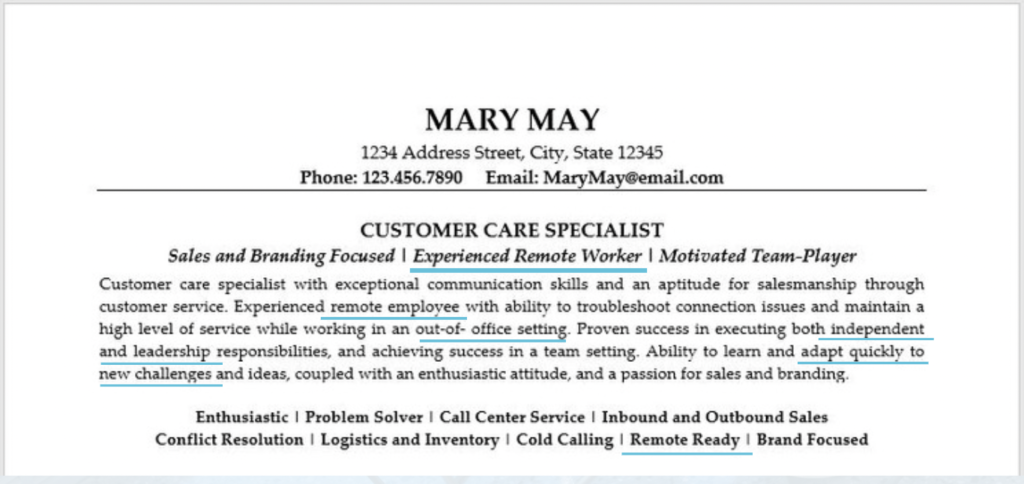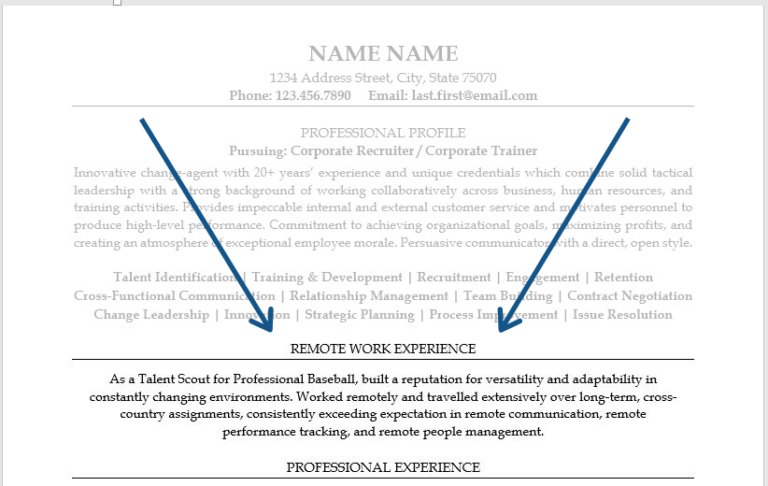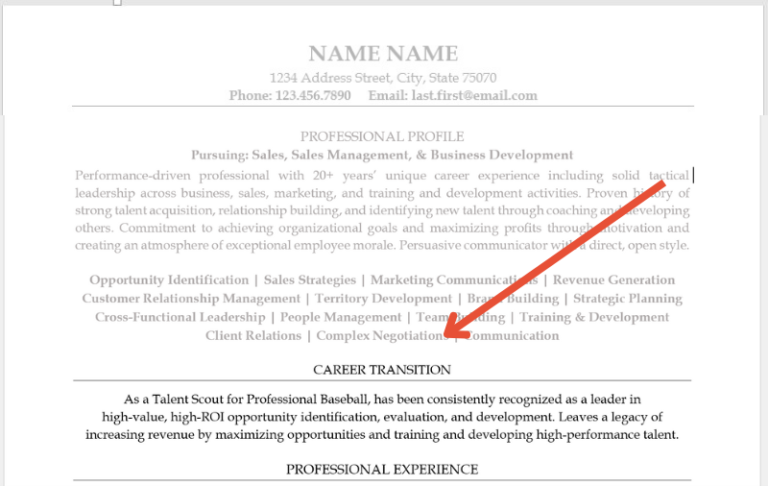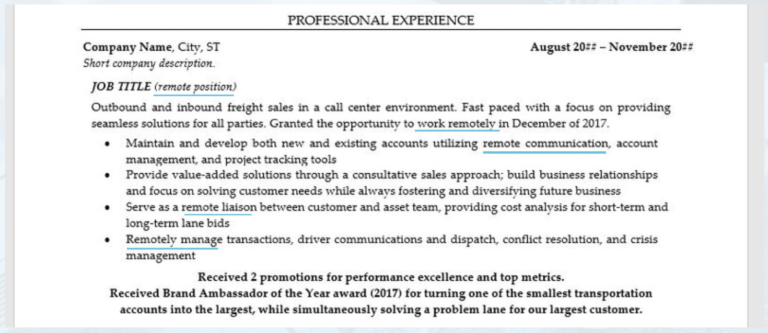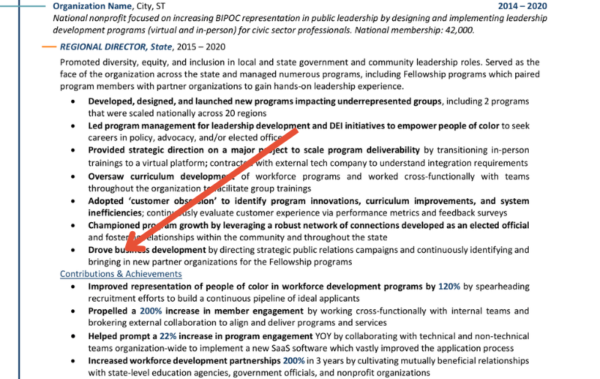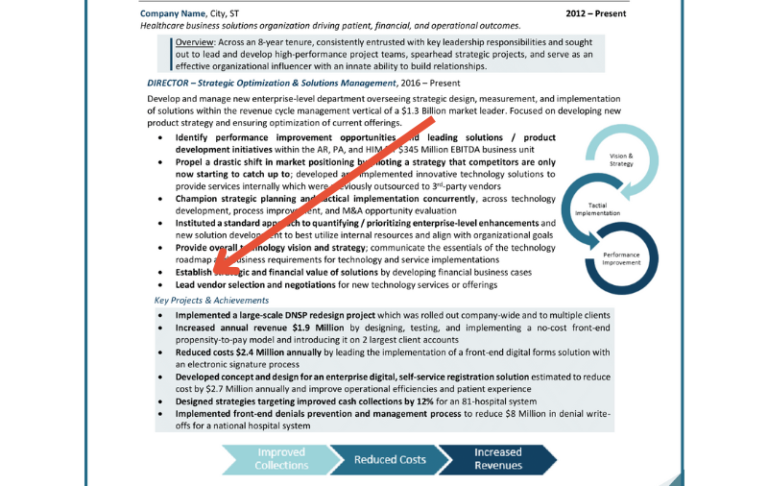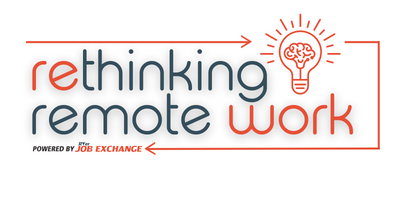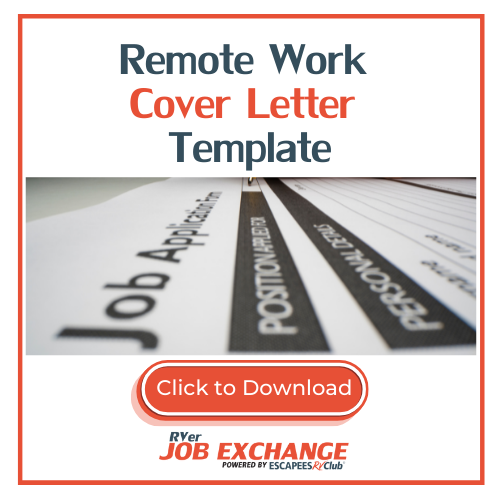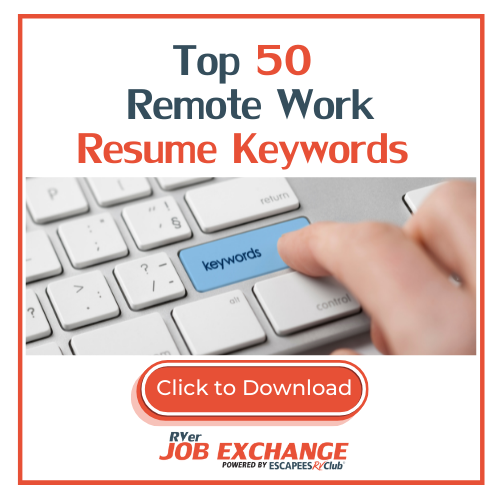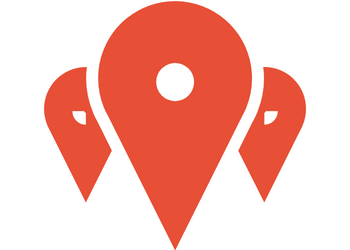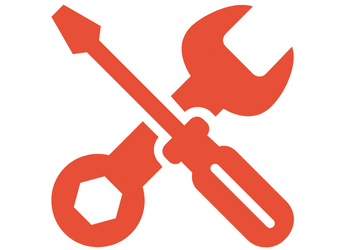Author: Lezlie Garr
-

10 Tips to Amplify Your Job Search
Continue Reading10 Tips to Amplify Your Job Search was originally published on ResumeLezlie.com.
Lezlie here, RVer Job Exchange Director. 👋
In my 10 years as a certified resume writer and career coach, every week I would get questions from job seekers at all levels across all industries that basically amount to, “Lezlie, how do I stand out from all the other job seekers out there?”
And since I’m a big fan of actionable tips, I’ve gathered some answers for you in an easy roundup list!
Enjoy these 💪10 powerful tips💪 to boost your callback quotient so you get more interviews and job offers.
10 Tips to Amplify Your Job Search 🔊
Table of Contents
- Get clear on what you’re pursuing
- Target companies first
- Laser-focus your resume
- Include a cover letter
- Diversify your job search
- Get active on platforms that work for your job search
- Create your own content
- Build more proof
- Focus on the value you bring
- Ask more questions

1. Get clear on what you’re pursuing
If you don’t set a clear intention, you’ll never get the results you want. The more broadly you try to apply yourself, the less likely you’ll be to fit any one position. Get crystal clear on the types of roles you want to pursue and align yourself with the most common skills and keywords being required in those roles.
2. Target companies first
This is a major change from the way most job seekers do it – which is one of the reasons it’s so effective. Another reason is because it helps you ensure you find the right environment and the right job, instead of finding what feels like the right job, then getting into it and realizing the environment isn’t at all what works best for you.
3. Laser-focus your resume
Start by creating a resume that targets the general career area and/or types of roles you want to pursue. Study the job descriptions to understand the most common skills and keywords you should include in this master resume. Then for each new position to which you apply, spend 15-20 minutes making minor adjustments wherever you can to better align with that particular role.
4. Include a cover letter
For each new position, write a uniquely targeted cover letter that tells the reader why you’re a fit for that particular role or company. While it’s true that cover letters aren’t always read, that’s not always the point. And because (1) you never know if the person on the other end of your application will or won’t read your cover letter, and (2) so many job seekers don’t take the time to include a cover letter (especially not a carefully targeted one) – you can set yourself apart just by including one.
Check out our Remote Work Cover Letter Template!
5. Diversify your job search
This means don’t just rely on online applications. Get out there and network with other people in your field. Follow industry thought leaders and even career pros (coaches and resume writers like me) to keep yourself ahead of the game in your job search. Leverage how easy it now is to network digitally. It’s seriously the future – don’t get left behind!
Read up on Job Search Networking Strategies (that Actually Work).
6. Get active on platforms that work for your job search
Typically this means LinkedIn, but more and more companies are branching out to platforms like Facebook and even TikTok to source candidates. So get savvy, do some research, and figure out which platforms have the most upside for your particular job search.
Be sure to set up your RVer Job Exchange free account here.
7. Create your own content
I know this can feel intimidating at first, but posting your own thoughts, opinions, and intentions for the future of your career / industry / company does 3 things. (1) It allows you to be more visible to and findable by recruiters / hiring decision makers. (2) It gives you a platform on which others can engage with you (instead of you having to engage with others on their platform). (3) It gives you proof to point to in the interview process when you want to demonstrate your ideas, thought leadership, etc.
Read more about using LinkedIn for Networking in Your Job Search (to Get Hired Faster!)
8. Build more proof
Whether it’s social media posts like mentioned in #7 above, a collection of anecdotes / stories that help demonstrate your professional brand and skills, or a professional portfolio website, it’s important to be able to prove what you say in your resume or in an interview. Anybody can say they’re good at something, but without proof it rings pretty hollow.
9. Focus on the value you bring
It’s all about finding a match between the value you bring to them, and the value they bring to you. That means you have to be able to sell your own value, and do it in a way that specifically speaks to the needs of the company for that role. Take an honest inventory of the skills you have that most closely align with the needs outlined in the job description, and make sure you can communicate those skills confidently.
10. Ask more questions
Since it’s about finding a match between the value you bring to them, and the value they bring to you, that means you also have to know how to get the info you need to make an informed decision. For each new potential opportunity, figure out before hand exactly what you want to know, what your non-negotiables are, and make sure you ask about them. Not only will it help you seem more engaged, it will also help you waste less time with options you later find out don’t offer what you need.
-

How to Prep for a Job Interview...
Continue ReadingHow to Prep for an Interview (Better Than Your Competition) was originally published on ResumeLezlie.com.
Lezlie here, RVer Job Exchange Director. 👋
The importance of interview prep has been written on a lot. But what steps can you take to ensure you’re prepping the right information the right way so you can out-perform your competition?
That’s exactly the topic this blog covers. The idea actually came to me in a livestream I did on LinkedIn (I used to go LIVE weekly for #CareerTipTuesdays) when someone asked me “What’s the best way to prep for an interview?”
And 💥BOOM💥 all these ideas started just exploding in my head. So I thought, ‘Okay, that’s what the blog in April is going to be about.’
As I see it, there are several different ways to prep for an interview better than your competition. Some of the most important are outlined below:
How to Prep for an Interview (Better Than Your Competition)
Table of Contents
- Empowering Yourself
- Research Strategies
- Compelling Content
- Must Ask Questions
- Digital Considerations

1. Empowering Yourself in the Interview Process
The absolute best way that you can make sure that you ACE your next interview is to up your confidence, leverage your value, and shift the power dynamic to put yourself on equal footing with your interviewer.
I had a really interesting conversation recently with a colleague, Anthony Vaughan, and he talked about that idea of shifting the power dynamic. Anthony works closely with job seekers on doing that prior to an interview, and it ties in really well with this empowerment topic.
It’s all about understanding that you have equal value. You’re on equal footing with your interviewer, and you get to choose whether or not you want that job just as much as they get to choose whether or not they want you for it.
In order to empower yourself and get into a place where you’re really harnessing your power, it takes some mindset work.
It’s a lot of retraining your brain to understand that the interview is a two-way street.
That’s the first thing I want you to remember about interviewing. It is just as much about you finding the right fit in the job as it is about them finding the right fit for the job.
Many job seekers come to me in this position where they feel powerless and they want to make themselves as appealing as possible to as many jobs as possible. They ask me questions like, ‘How do I make myself look good / sound good for this role?’
The first question I ask is, ‘Is this a role you’re really interested in or passionate about?’ Often, the answer is ‘No.’
It’s just that they’re in such a place of fear, that they’re less focused on what’s right for them and more focused on just getting a job.
And let me just say that if that’s truly the position you’re in, I wholeheartedly support you in getting a job, any job so you can put food on the table and pay your bills. But then keep going.
Keep up that job search until you find something that aligns with your values and priorities. And when you do find those types of jobs, remember this blog to help you keep your power in the hiring process.
Throughout the entire interview process, you can keep your power by remembering that it’s a two-way street, and you have just as much deciding power as they do.
Another way to harness your power is to keep in mind that by the time you get to the interview process – especially once you’re past that first initial screening – they want you to be the one.
Hiring and interviewing are complex. It’s an exhausting, time-consuming process, and everyone is happier when the person that goes in there is the right person.
With the rare exception of intentionally difficult interviews/interviewers, most of the time they’re rooting for you to knock it outta the park. It makes their job so much easier.
Truly.
They don’t want it to be an uncomfortable, awkward situation. They don’t want it to be a lost cause or a waste of their time. They want you to be the one.
So, keep your mindset in that power zone, make sure that you’re really leveraging the idea that you get to choose.
You get to be the decider.
Along with mindset work, you really want to balance that out with good prep work, because being well-prepared is another one of the best ways to optimize your power.
The rest of the topics in this blog are going to help make sure that you’re researching the right things and compiling the right content so you feel confident and at ease in the interview process.
This will help your interviews feel more like a conversation between two equally-footed professionals, and not a situation where they have way more power.
2. Research Strategies
When it comes to prepping for an interview, doing thorough strategic research is key to boosting your confidence and elevating you above your competition.
The first area of research you can focus on is to research the company.
For many job seekers, this research is done early-on in the job search process. This allows you to target specific companies you’re interested in, instead of relying on the companies who have jobs listed on LinkedIn or Indeed.
If you haven’t done the company research beforehand, then that’s where you want to start.
The first thing I recommend is just going straight to the company website. Just by doing this, you can get a good feel for what’s important to them and what’s important about the type of person they want to hire.
You can read through the home page, look for those large text statements on the homepage at the top or throughout that tell you about how the company wants to be perceived.
This will tell you how to set your mindset, to be sure that you’re answering questions in a way that speaks to their priorities.
It will also help you to decide whether or not this company is a good fit for you.
(Because, remember, you get to make decisions each step of the way. So just because you’re offered an interview, if you look into it and decide, ‘This is not the company for me’, you don’t have to take that interview.)
Doing this research, going to the website and just looking through their homepage can give you a little bit of a feel of the type of people they want working at the company and the type of people they want to hire.
You can also look at the About page, which can often be a way to find out some of these same things.
You can look at their Careers page, because a lot of times, aside from just having jobs listed, they will have some descriptions about the type of people they want to hire.
You can also look at their Media / Press / In the News page which will show you the types of things that company is putting out, because those are going to be things that they’re typically proud of and that are important to the company.
You can even look for any new developments going on for the company. Anything that will help you get a better feel for what type of person they want to hire.
All of this can help you figure out how you can present yourself as closely to that type of a person as possible.
Other sources of info include the company’s social media presence. Learn what subject matter they post about so you can get a better feel for topics of conversation and/or ways that you can align yourself with the company.
You can also just go straight to Google and do a Google search for the company’s name. You will often find pages from the actual company first, but if you go through to the second or the third page of search results from Google, you’ll start to see things that come from news outlets or press or or other 3rd parties.
All of this stuff is going to inform the way you answer interview questions.
It’s all about just finding as much as you can about the company that can potentially help you answer questions in the interview.
You can also look at online reviews for the company. Glassdoor.com is a really well-known website that has a section where actual employees from companies can come in and leave reviews about what it’s like to work there.
While this can be a great resource, always take reviews with a grain of salt – especially if you find just 1 that’s awesome and the rest are bad, or vice versa.
You really want to look at the bulk of what’s out there and get a feel for sort of the overall reviews that are coming in about the company.
You can also identify a competitive advantage or disadvantage that the company has by taking a look at their competitors in the space and seeing what you can find.
It can be a great way if you find a competitive advantage and come into the interview and able to say something like, ‘I’m really excited about this company, because I noticed they have a competitive advantage in blah, blah, blah…’
Immediately, the interviewer can tell you did your homework and looked into this company.
On the other hand, if you find a potential competitive disadvantage, this can be something that might help you to brainstorm ways that you can bring unique value to improve that area.
The next area to research is the role.
Get really familiar with the job description. Read through it several times to get a feel for what the most important skills and strengths are that they’re asking for, and also what type of person they’re trying to hire.
Often, there are words in the job description intended to describe both the technical aspects of the job and to describe the type of person they’re looking for.
Make sure that you really pay attention to both sides.
Researching the role also includes understanding salary expectations by looking up the average salary for that role in your area. The data you find should only be used as a guide, so be careful not to get too attached to any one salary figure you find in your research.
You can also research comparable roles in other companies to get a feel for their differences or similarities to the role that you were looking at.
Finally with research, you can research the people that you will be interviewing with.
You usually will get at least one name of someone you’ll be interviewing with, and hopefully you’ll get their job title/role, too.
You can use LinkedIn to research their background and look for similarities that you have or some other way you can show alignment with them or maybe flatter them in some way.
Anything you can do to set a positive rapport is going to be helpful.
All of this research goes to help you establish a foundation for success in the interview. If you do the proper research, it’ll all be sort of knocking around in your head when they’re asking questions and you can pull whatever you need to that benefits you in the moment.
3. Compiling Content
This is another really important piece of the preparation process.
Anybody can say that they have certain skills, but without proof, it really doesn’t mean much.
So, compiling effective content for your interview will help you showcase your skills and demonstrate their real-world applications.
The first piece of content I’ll recommend having (even though it will seem obvious as soon as I tell you) is your resume.
During the interview process, whether it’s in person, over the phone, or via video call – have you resume available to reference if you ever need to.
This is helpful if someone asks about something specific from your resume, because you can look back at those words on your resume and go, ‘Oh yeah, this is what I want it to say.’
This will help you to make sure you’re staying on brand and staying on message.
I also recommend to strategically stockpile stories.
This is a really helpful way to go beyond what your resume says and actually prove that you have the skills and/or experience the resume says you have.
If you have a short anecdote or example from a real experience in your career (even potentially in your personal life, depending on what it is), those stories can go so far in helping to demonstrate that, yes, you actually do have those skills and they have real-world applications.
Try to stockpile stories to go along with each of the main skills you highlight in your professional brand. This will help you stay on message and be prepared for as many interview questions or scenarios as possible.
You can even create a spreadsheet that aligns your stories with their relevant matching skills, to make it as easy as possible for you to prep for interviews. (This idea came from a recent client of mine, and I thought it was brilliant!)
Another piece of the stockpiling puzzle is a portfolio.
A portfolio is a compilation of projects, achievements, successes, articles, or other specific content that helps demonstrate your skills and experience. It’s anything that further goes to demonstrate what you’ve done, and the fact that you do have the skills you say you have.
Finally, compiling effective content also includes practicing answering common interview questions.
While you’re not usually going to be able to predict what questions you get, but if you know some of the most common ones, you can practice answering those from the perspective of what you’ve learned from your research and make sure that you’re answering those questions in a way that really aligns with and speaks to the things you know company is wanting out of hiring someone.
4. Must-Ask Questions
Asking the right questions in an interview can go a long way in helping you to decide whether you want to work there.
It can also go a long way in helping the interviewer to better see your value.
It’s good to have a specific question or a couple of specific questions that really dig into the role itself that weren’t asked (or answered) during the interview.
Another thing to think about when it comes to asking questions is you can ask questions that subliminally tell the interviewer that you’re a serious candidate, and that you’re the type of person who goes above and beyond.
One great question you can ask is, ‘What are some of the core challenges of this role and what resources are available to help overcome them?’
The first half of this question helps you to get a read on what the challenges really are and whether or not you’re ready to meet those challenges.
The second half of the question is an excellent way to help you gauge what kind of company it is; are they the kind of company that helps provide resources to overcome challenges or are you just in it on your own and you gotta figure it out?
Another great question is, ‘What pains could I alleviate by coming on board?’
This question was shared with me by another colleague of mine, Kate Pozeznik. One of the things she mentioned about this question and about the interview process in general is that it’s sort of like selling, and part of that selling process often is bringing out the pain of the buyer and how you can help alleviate that pain.
So by asking this question, you’re basically putting the interviewer in the situation of having to sit in that pain and think about what it is that they’re struggling with because of not having someone in that role, which can be really helpful from the perspective of you, the candidate.
Another great question is, ‘What makes someone successful in this role?’
This answer will often will come down to personal soft skills or things that really are innate within a person, and that can help you figure out if that’s a good fit for you.
It also can just be helpful to hear that person describe those things and make sure that they’re hitting on things that are important to you. If they’re only talking about working overtime or dealing with high-stress, you can decide whether or not that’s a good fit.
Often it comes down to listening to what’s not being said or ‘reading between the lines’ that helps you assess them and also helps them assess you through this question-asking process.
You can also ask things like, ‘What does the company do to encourage diversity? And how does it support employees from marginalized social communities?’
If you have specifics, if you want to ask about the LGBTQ community and how they support that or how they support their BIPOC employees, all of these things are fully valid questions.
You have every right to ask them.
And if it’s important to you that you work for a company that values these things, then I would say it’s pertinent to ask this question, because that will give you the answer on that subject.
Beyond getting their answers to questions like this, you also want to do your own research and make sure they are walking the walk and not just talking the talk.
You can research who their leadership is to see if it’s diverse, you can research who’s on their board, you can research what types of community activities / support / initiatives they do, and then make sure that aligns with whatever answer they give you to that question.
In total, you should probably ask 3 to 5 questions. No more than that.
And you want to end it with a question about what the rest of the interview process looks like, what the next steps are, or when you should expect to hear from them.
This will, again, put you in the driver’s seat and give you the power to understand what the process is and/or what the next steps are.
For more insights about asking the right questions in interviews, check out this article from my Colleague Nii Ato Bentsi-Enchill entitled, What the Questions you Ask in Interviews Reveal About You.
5. Digital Considerations
When it comes to digital considerations, you want to make sure technical difficulties don’t stand in your way, and that you can even use the technology to your advantage as much as possible.
For example, one of the aspects that I mentioned in the Compiling Content section of this blog is a portfolio. Many of you may be wondering how to showcase your portfolio during a virtual interview.
I think it depends on what platform you’re using, but there are definitely ways you can get some of this information in front of your interviewers.
For starters, you can mention at the beginning of the interview that you compiled some potentially helpful information for them and that you might refer to throughout the interview. You can ask if you are able to share your screen, or if you can send a quick email to them containing this content.
Another way to leverage technology during an interview to showcase unique content is a tactic that was first introduced to me by Austin Belcak, which is to create your own virtual background to use in Zoom (or other platforms) calls.
You can use Canva to create the digital background, and you can include major concepts or pieces of your brand right on the image. You can even match the colors in this image to any used in your resume, portfolio, or personal website.
(Remember not to add too much to the background image, because that will make things look busy. And avoid including any content in the space where your body will be.)
Another important factor with technology is to make sure you test it all ahead of time.
Even if you do test it all ahead of time, you may still have some technical difficulties, but at least you can say you did everything you could to prepare ahead of time.
And if technical difficulties do arise – try to stay calm! IT’s a great way to show how you perform under pressure. 😉
Another digital consideration is your lighting.
Some of the best advice out there says to find natural light as much as possible. So, if you’re able to set up in front of a window and the light is shining on your face, that’s fantastic.
If not, you just want to make sure there’s a lot of light (more than you probably think) to light your face, that you’re not too backlit (so you look like a silhouette), and that you don’t have a lot of shadows on you.
For your audio, you should consider your audio equipment, and also your surroundings / environment. If you are in a room that’s very ‘live’ (which means there are a lot of hard surfaces for the sound to echo and bounce off of), that could be distracting in your interview.
You may want to figure out a way to either pad parts of the room or find a different location so things aren’t so echo-y.
If you don’t have a virtual background you’re going to use, there’s a couple of things to think about in your actual background.
Mostly you want to make sure it’s not too messy or distracting. You also want to make sure there’s nothing ‘inappropriate’ or ‘unprofessional’ that would distract from you and the value you bring.
You want everything in your background to be a nice supplement to give a little visual intrigue, but that your interviewer can still really focus on you.
And finally, with your virtual interviews, you want to make sure that you are really emphasizing your interpersonal skills.
It is harder to make a connection virtually because you aren’t actually interacting with anyone in-person. It’s all just you in front of a camera and a computer screen.
So, you gotta learn to treat the camera like it’s a real person, because honestly there are real people on the other end.
As you’re practicing your interview, make sure you’re looking into the camera, make sure you’re smiling. If you’re a person who talks with your hands (like me), you can feel free to do a little bit of that, too. You don’t want to force yourself to sit too still and feel too stifled.
Make eye contact with the camera, pretend it’s someone you like.
I say that about in-person interviews, as well as looking at the camera for digital interviews. One of the things that has really helped me is to pretend that the person I’m talking to is someone I really like. I don’t think of a specific person, though you certainly could, if it helps you.
For me, it just helps to pretend there’s someone I like and get excited to see on the other side.
When I’m recalling those feelings of seeing a person that I really like, that makes me happy to be around, it can really make my smile more genuine and can make it feel warmer when I’m talking.
-

Setting Yourself Apart in Each Career Level...
Continue ReadingSetting Yourself Apart in Each Career Level (and Situation) was originally published on ResumeLezlie.com.
Lezlie here, RVer Job Exchange Director. 👋
One thing I know for a fact after all these years as a resume writer and career coach:
Job seekers focus too much on where they’re lacking, and not enough on the unique value they bring.
You have unique value to offer.
Yes, you. Reading this blog right now.
Your career trajectory is unique and because of that you have unique value to offer that no one else has.
If you’re sitting there thinking, ‘Yeah, but not me though’, learn to flip the script in your head and recognize your value.
A deficiency mindset does you no good in your job search, your career, or really anywhere in life.
Figure out what your unique value is.
Pinpoint it, believe it, and learn to communicate it effectively.
It’ll do you a world of good.
And to get you started, I’ve compiled tips to help you leverage your strengths and position your value, no matter what your career level or situation.
(Please note that in your job search, it’s important to target a specific career area or job type and tailor your communications to your target audience. All of the information in this blog is included with that foundational understanding in mind.)
How to Set Yourself Apart in Each Career Level (and Situation)
Table of Contents
- All Career Levels
- Early Career
- Mid-Career
- Senior-level Individual Contributor
- Senior Manager & Up (Director, VP, Executive)
- Career Change / Return to Work
- Remote Work
- Work Camping (or Workamping)

1. All Career Levels
One thing that can help you stand out at any career level or in any career situation is a strong cover letter. Even though the cover letter won’t always be read, that isn’t always the point.
Learn more why a cover letter is important and check out our Remote Work Cover Letter Template!
2. Early Career
Early career professionals span anywhere from students to grads to those with up to about 5 years of career experience.
At this level, it’s easy for many to fall into the trap of believing they have very little to offer, or that they have nothing unique to offer that sets them apart from the masses.
There are a lot of nuanced ways to demonstrate your knowledge, experience, and ultimate value, even as an early career professional.
College Course Names
At this level (especially for students and grads), including the names of relevant college courses or projects on your resume is an excellent way to (1) demonstrate the details of your degree plan, and (2) get some additional relevant keywords into your resume – at a time when your official work experience may not yet include them.
You can also reference relevant courses or projects in your cover letter or during the interview process to help further demonstrate the real-world application of your skills.
Internships
At this level, internships can often be given the same level of detail as you would an employment position (though please note that you should never intentionally misrepresent internships as employment).
Internships can be a great way to show how you operate in a work environment, how you handle entry-level functions of the role, and what you’re able to achieve when given real-world opportunities.
Unrelated Jobs
Many professionals at this level consider leaving off unrelated jobs they worked while going through college, or they include the jobs with very simple and totally non-relevant job descriptions.
It can be much more beneficial to list those jobs and translate the descriptions so they’re easier to understand by your target audience. This often requires some outside-the-box thinking, but when done correctly can really help add value to your experience.
Volunteer Experience
Much like internships, volunteer roles can often be given the same level of detail as an employment position and they can be a great way to show how you operate in a real-world work environment.
When crafting descriptions for these, use the same creativity you did in your unrelated jobs to make sure you’re communicating the responsibilities of the role.
3. Mid Career
Mid-career can encompass anyone with 5-15 years’ experience, give or take a year or two in either direction on either side, depending on the unique experience of each individual.
At this level, it’s important to be able to show accomplishments of some sort. Being able to communicate and/or demonstrate your achievements and accomplishments is one of the best ways to show your potential and to elevate yourself above other candidates with similar experience.
TIP: If you don’t make it a practice to track your achievements as they happen, I recommend getting started on that right away. It will make this process a lot easier and it will help you immensely in your job search and throughout your career.
Another important way you can set yourself apart at this level is to be able to demonstrate your reputation.
What have you become known for so far in your career, and how does that bring value to your colleagues, superiors, and/or the company as a whole? This insight can help hiring decision-makers to better understand who you are as an employee and how well you would fit in the role they’re hiring for.
Finally, at this level it’s important to be able to communicate your plans and goals for the future of your career, and your strategies for achieving them.
Being able to communicate this is a great way to show that you’re being intentional in your career and you’re moving in a clear target direction. This helps to add a perceived sense of stability in you as a candidate and let’s the decision-maker know that you aren’t just there on a whim.
4. Senior-level Individual Contributor
Senior-level individual contributors have a lot of value to share from their expertise and career longevity.
At this level, it’s beneficial to focus on what you’ve built so far in your career.
Like in mid-career, individual accomplishments are important; but what can be even more powerful is to be able to show how your accomplishments have built up to something over time.
What major contributions to company success can you demonstrate?
And even though individual contributors often don’t have direct leadership they can point to, there are other types of leadership that show a lot of strength and value.
One important type of indirect leadership is the ability to rally support or influence others, even though you aren’t actually their supervisor.
If your colleagues listen to you and trust your judgement, or if they come to you for advice, that’s a unique skill that not everyone has. And it’s a high-value selling point – so if this is something you know you’re good at, use it!
Another type of indirect leadership is innovation, or leadership of ideas.
If you’re the type who’s consistently driving ideas forward, improving processes, and coming up with new, better ways of getting things done – that’s a really valuable type of leadership, too. Especially if it involves presenting these ideas to company leadership and making a case for their relevance / importance. Not everyone can do that.
5. Senior Manager & Up (Director, VP, Executive)
This level is when you’ll really start to show complexity of leadership.
Beyond the leadership skills mentioned above, you also want to show your abilities in higher-level strategic planning.
This may include your ability to beyond leadership and talent development to really create strategy in succession planning. Or how you’ve successfully collaborated with other leaders to achieve business objectives.
Consider how you’ve brought innovation or been a leader of change in your organization.
It’s also important to be able to show a broader understanding of how your work – and the people / operations you lead – effect the success of the company.
Through this, you can show your ability to identify and mitigate business risks and ultimately help provide the right forward trajectory for the company.
Communicating these more complex aspects of leadership will help set you apart at higher levels.
6. Career Change / Return to Work
The first thing I want to emphasize is that you have unique value, and you get to tell the story of your career.
It can be easy for us to feel insecure when our career background is a little disjointed or non-linear, and we start to feel like that’s all anyone is going to see when they consider us.
And that’s probably true – if that’s the way you present yourself on paper or in your online profiles.
But, if you take a step back, look at the big picture, and think outside the box to figure out how to tell your story in a way that connects the dots in a way that you know the connections are there.
You wouldn’t be interested in this new career area if there weren’t reasons from your background that make you feel that way.
For most people – you know, deep down, that you’re qualified for those jobs, otherwise you wouldn’t be so excited about it and drawn to it.
So if you can connect the dots of your ‘non-liner’ background for them, they’re going to see whatever story you put in front of them.
You’re the storyteller – you get to choose how the story goes.
The trick is to be able to identify that for yourself and learn how to communicate that in a way that your new target audience understands.
Go deep with your research into your new target positions so you can translate your language from that of the old industry into that of the new.
The next major concept I want to share with you is about transferable skills.
There are a lot of misconceptions about transferable skills, and the biggest thing I want you to be aware of is that ‘transferable skills’ aren’t just one set of particular skills that are considered ‘transferable’.
Transferable skills can be just about any skill that you have, so long as you can prove it’s applicability to your new target career direction.
You have to be able to identify the skills that are transferable, and communicate and demonstrate how they are of value to your new pursuits.
Again, this all comes down to the idea that you’re the storyteller. You get to construct the narrative.
It can take some outside-the-box thinking to identify your unique set of transferable skills, so I want to help illuminate some important skills that are often common in successful career changes. (And these actually apply to both career change and return-to-work.)
Quick learning skills
For someone who is returning to work or embarking on a career change, being able to pick up new skills, processes, and concepts quickly is important. Demonstrating that you can do this will help set hiring manager’s minds more at ease and could potentially help elevate you above other candidates.
Often, just saying you’re a quick learner is not enough to carry the impact you want.
Instead, if you can demonstrate in your resume (and/or throughout the interview process) the various times when you picked up a new technology or learned a new system quickly, that goes a lot further in proving that you actually are a quick learner.
Versatility & Adaptability
For someone returning to work or making a career change, it’s also important to be able to show your versatility and/or adaptability. This will help reassure hiring decision-makers that you will be able to catch-up with changes that have happened since you left the workforce, or any new concepts that come up in your career change.
‘Unofficial’ Work
Volunteering for an organization or taking up roles for your child’s school both take time, and often a great deal of skill, too.
These pieces of your background can (and should) be incorporated into your story if they help demonstrate what you were doing during a time of unemployment, or if they can prove your experience in a new career area you’re pursuing.
7. Remote Work
Often when transitioning into remote work, it can be difficult to identify the skills we have that transfer into that type of work, because we’ve never ‘officially’ done it before.
But the truth is, there are lots of ways to demonstrate your ability to work remotely, even if you’ve never done it before.
First, you can focus on demonstrating your remote work skills. And while remote work skills – much like transferable skills – aren’t necessarily a set group of particular skills, there are some common skills that will help potential employers feel more trusting you as a remote worker.
You can start by doing research on remote work skills to identify a short list of skills that resonate with you and you feel like you can demonstrate in your work history.
Make sure you use those skills throughout your resume, in your branding materials (like your portfolio or LinkedIn profile), and in your interviews.
Another thing to think about is situations from your work that weren’t necessarily you ‘working remotely’, but that had you functioning in a remote (or remote similar) way.
One example of this is roles in which you’ve had a lot of autonomy, because working remotely requires you to be able to work effectively in an autonomous environment.
Another example of the is cross-locational collaboration or leadership. If you’ve worked in a role that required you to collaborate, manage, or lead across locations, perhaps regionally, nationally, or even globally – that’s a big example of your ability to work effectively in a remote capacity.
In your resume, you might be able to craft a sentence that talks about utilizing ‘remote work skills, technology, and operations while working cross-locationally to…’
You can also demonstrate remote work abilities in situations where you collaborated or managed off-site personal. Even if you were the one going into the office and working from there, if you managed or collaborated with personnel offsite, that’s still working in a remote capacity.
When it comes to remote work, really get creative to get those remote work skills into your descriptions and to emphasize the job functions that may not have been ‘officially’ remote work, but were similar.
8. Work Camping
This portion come from Finding Seasonal Work From Your RV which was originally published on www.xscapers.com
As with any job, the best place to start is by taking inventory of what you love to do and what you’re awesome at. From there, you should brainstorm ways to turn that into seasonal work.
Into crafts? Search for crafting conventions or a touring craft fair that might need extra workers in a place you want to go.
Love all things RV? RV shows happen all over the country and are usually hiring.
One with nature? National, state, and county parks are always on the hunt for cool people.
Once you’ve figured out where your passions lie, you can get about the business of finding people who’ll pay you for them. Here are some resources for that:
- RVerJobExchange.com – Jobs to fuel your remote lifestyle! Create a FREE account and find jobs that meet your lifestyle needs. Your Job Candidate profile will unlock the doors to jobs powered by Escapees RV Club.
- Coolworks – Find cool jobs in cool places on this well-respected platform.
- Workaway.info – This is a great site for ranch/farm type opportunities, but it also has a huge selection of other wicked cool jobs all over the world.
- Jobs with National Parks Service – All seasonal and full-time opportunities are listed on this site.
- Join Facebook Brand Ambassador groups – Brand Ambassador is the industry term for someone doing promotional work at an event. When an event comes to your area, they’ll likely post openings to a local brand ambassador Facebook group.
- Workamper – One of the best resources for finding jobs at RV parks and campgrounds.
- Network, network, network – Whether you’re wanting to work a sweet concert, get a job in a cool town by a national park, or host at a campsite, you’ll give yourself a huge leg up by getting to know the right people.
Once you zero in on what you want to do and where you want to do it, try to get yourself to that spot and about the business of getting to know who you need to know to get hired.
Remember:
You control the narrative.
You get to tell the story. So craft your story in a way that empowers you and showcases your most relevant strengths in a compelling way that speaks directly to your target audience.
-

6 Tips for Your Remote Work Resume
Continue ReadingIf you’re currently searching for remote work or in the midst of a remote job search, you might be wondering how to list remote work on your resume or LinkedIn profile – and how much it really even matters.
We can assure you, it matters a lot!
With these 6 tips (and remote work resume examples to go with them!), you’ll learn more about how to show remote work on your resume in a way that catches recruiter attention and showcases your top skills!
How to Write Remote Work on Your Resume (and LinkedIn Profile)
Table of Contents
- Make it clear you’re targeting remote work
- Use effective resume formatting
- Include remote work skills
- Write compelling job descriptions
- Showcase your results
- Transfer it over to LinkedIn

1. Make it clear you’re targeting remote work
You can indicate remote work on your resume right away by including a line in your contact info, in your targeting headline, in the body of your summary / profile paragraph, and/or in your skills section at the top of your resume.
Resume Example:

Resume Example:

2. Use effective resume formatting
Your resume format is often your first impression. Before anyone reads your content, they see (and judge) your formatting. It needs to be clean, easy to read, and purposefully guide the reader’s eye to your most important content.
There is a very definite ‘look’ to a well-crafted resume, and while that ‘look’ may vary in style, the basic formula is pretty consistent.
A good remote work resume should include:
Contact info at the top
This includes your name, phone number, email address, and indication of remote work preference (remote only, remote first, hybrid, etc.)
Targeting Headline (and sometimes sub-heading)
Indicating the types of jobs you’re targeting
Summary / Profile paragraph
Showcasing your top skills, achievements, and experience
Skills section
Full of highly targeted keywords for your target remote jobs
Professional Experience
Listing your jobs in reverse chronological order
Other important sections may include:
Remote work section
Career transition section
Education
Technical skills
Remote work skills
Remote Work Section Example:

Career Transition Example:

3. Include remote work skills
To create an effective remote work resume, it’s all about demonstrating how you fit the needs of your target audience and can provide a solution to their pain points. You can do this through remote work keywords and skills.
If you’re not sure how to find the right remote work resume keywords for your purposes research the job descriptions for the jobs you want to target. To do this:
- Collect at least 10 job descriptions that represent your target remote job type
- Highlight words or phrases that stick out to you or seem important in each one
- Copy/paste each description into a word counter (I like WordCounter.com)
- Analyze the data to understand which words/phrases are used more often
- Create a database of the keywords that are most used and most relevant
Check out our Top 50 Remote Work Resume Keywords for great remote work skills!4. Write compelling job descriptions
Using your database of keywords from #3 above, write each of the job descriptions in your Experience section with those skills in mind and try to include those skills wherever possible. If the job was remote, you can indicate remote work in the job title or location, as well as in the description itself.
Even if you’ve never worked remotely before, you can include some remote work keywords by describing work that may have required you to work with people in other locations (cross-locational is a great remote work keyword), to work from home, or to travel for work.
Check out our 25 Remote Work Job Description Examples to help revamp your resume!Resume Example:

5. Showcase Your Results
Results and achievements are the major factors that prove your value. Anybody can claim they have skills in something. So don’t just fill your resume with empty claims.
Fill it with proof.
That’s how you elevate yourself above other candidates competing for the same roles.
Resume Example:

Resume Example:

6. Transfer it over to LinkedIn
For anyone targeting fully remote work or even hybrid roles, LinkedIn is a great place to find those jobs and to be found by recruiters.
The content in your remote work resume can be easily transferred to your LinkedIn profile, and the following bit of info should help:
- Your resume summary/profile content should be added to your profile Headline and About sections.
- At the time of this publication, the Headline section has a maximum character count of 220 on desktop and 240 on mobile, and the About section has a max of 2600. The LinkedIn algorithm (supposedly) ranks your profile higher in search results the closer you are to reaching that limit in each section.
- Your job descriptions should be pretty easy to copy/paste directly from your resume to your LinkedIn profile. When adding each employer, be sure to select the correct employer profile, which will hopefully pop up with the employer’s logo and make your profile look better.
- Your skills section can have a maximum of 50 skills, and the more you have the better. Make sure to use the keyword research you did for your resume to know which skills are most important to include.
- Pro Tip: Another way to help your profile rank higher in search results is by actually being active on LinkedIn: connecting with others, following companies and industry influencers, posting your own posts, sharing posts from others, and/or commenting on others’ posts. The more active you are, the more visibility you will get and the higher the algorithm will rank you in search results.
Attend our (free!) Rethinking Remote Work virtual conference to learn even more about breaking into (or moving up in) the remote work revolution!

-

Remote Work Cover Letter Template
Continue ReadingDoes just the thought of writing a cover letter make you roll your eyes?
You’re not alone.
But lots of companies (of all sizes and industries) require cover letters.
And while it’s true that many hiring decision makers don’t read them – some do.
Are you willing to risk your chance at that job on, “they probably won’t read it”?
Not to mention, many of those who don’t read them still admit to believing cover letters are an important part of the candidate package.
So instead of continuing to put off writing a cover letter – get brave and learn to write one that will help you stand out.
And don’t worry, the RVer Job Exchange has your back!
We’ve created a Remote Work Cover Letter Template to get you started.
It’s a fully customizable template and even includes instructions on how to use it and additional content to give you inspiration for each new cover letter you write!
Don’t miss out!
Get your free Remote Work Cover Letter Template here:
-

25 Remote Work Job Descriptions for Your...
Continue ReadingKnowing how to write effective job description bullets in your resume is a crucial part of job search success.For instance, did you know that a simple switch-aroo to put the result in front of the action helps turns a mediocre bullet point into a super engaging one?It’s a storytelling tactic called ‘in media res’, where the story starts with the most exciting moment, and then pulls back to the beginning to tell the rest. Movies and TV shows like 𝘛𝘩𝘦 𝘎𝘦𝘯𝘵𝘭𝘦𝘮𝘦𝘯, 𝘗𝘶𝘭𝘱 𝘍𝘪𝘤𝘵𝘪𝘰𝘯, 𝘏𝘰𝘸 𝘵𝘰 𝘎𝘦𝘵 𝘈𝘸𝘢𝘺 𝘸𝘪𝘵𝘩 𝘔𝘶𝘳𝘥𝘦𝘳, and 𝘉𝘳𝘦𝘢𝘬𝘪𝘯𝘨 𝘉𝘢𝘥 (to name just a few) do this to engage audience attention right away.And YOU can use it to get recruiter attention with your resume. Just look for places to pull that simple switch-aroo and put the most exciting thing – the result – first.Switch-aroo Example 1:“Developed new integrated retail strategies which delivered 53% online growth”to“Delivered 53% online growth by developing new integrated retail strategies”Switch-aroo Example 2:“Implemented and led a new sales initiative which resulted in $1 Million in increased revenue”to“Propelled $1 Million in increased revenue by implementing and leading a new sales initiative”Switch-aroo Example 3:“Developed strong vendor partnerships which helped enhance ad share-of-space 15% and drive departmental margin 26%”to“Enhanced ad share-of-space 15% and drove departmental margin 26% through strong vendor partnerships”These all help you get recruiter attention by putting the most exciting moment first.Need some inspiration to write better job descriptions on your resume?Our 𝟮𝟱 𝗥𝗲𝗺𝗼𝘁𝗲 𝗪𝗼𝗿𝗸 𝗝𝗼𝗯 𝗗𝗲𝘀𝗰𝗿𝗶𝗽𝘁𝗶𝗼𝗻𝘀 𝗳𝗼𝗿 𝗬𝗼𝘂𝗿 𝗥𝗲𝘀𝘂𝗺𝗲 will help!Download them here: -

Top 50 Remote Work Resume Keywords
Continue ReadingDon’t sell yourself short in your remote work resume!
Target remote roles by including strong, hyper-relevant keywords that show your skills in working remotely.
(Don’t be afraid to get creative! Just because you’ve always technically had on-site jobs doesn’t mean you haven’t developed remote work skills.)
Keywords play a major role in resume success. Especially in online Applicant Tracking Systems (ATS). Without the right keywords, it’s unlikely your resume will make it in front of an actual human.
And once a real human does see your resume, keywords help them to see your relevant value.
Download our 𝗧𝗼𝗽 𝟱𝟬 𝗥𝗲𝗺𝗼𝘁𝗲 𝗪𝗼𝗿𝗸 𝗥𝗲𝘀𝘂𝗺𝗲 𝗞𝗲𝘆𝘄𝗼𝗿𝗱𝘀 now!
-

12 Easy Ways to Boost Your Job...
Continue ReadingFor remote work, workamping, and all job seekers alike.
ALL JOB SEEKERS
1. Update your resume
Having an up-to-date resume at-the-ready is crucial to making your holiday job search a success. You never know when the right role will come along, so be sure your resume:
- is targeted to the roles you’re pursuing,
- highlights your strongest and most relevant skills (with real-world examples whenever possible!), and
- showcases your most impressive results (including specific metrics/numbers/percentages, etc. whenever possible!)
Check out our blog on How to Position Yourself for Remote Work for more info on updating your resume!
2. Develop your elevator pitch
An elevator pitch is a short, succinct introduction of who you are (in your career) and what you have to offer a potential employer. This should be just a few sentences, and should really highlight and showcase your unique value.
3. Determine your job search strategy
Plan your strategy and daily/weekly/monthly schedule now, so you’re ready to hit the ground running in the new year. Determine how and where you’ll be applying for jobs and how you want to conduct your networking (ie. how often you’ll be on social media, how many you people you want to email/direct message, and how you want to follow up to maintain these relationships). Read more about networking strategy in our blog on Job Search Networking Strategies that Actually Work.
4. Practice common interview questions
Since you can’t ever predict what questions you’ll be asked in an interview, the next best thing is to prepare your own unique answers to common interview questions. This will help you to do well in answering those questions, and will also help you to feel more confident and able to answer other, unexpected questions more easily. Learn more about prepping for interviews in the Interview video on our Career Fair Resources page from our virtual career fair this month.
REMOTE WORKERS
1. Update your LinkedIn profile
LinkedIn is the most important social media platform for remote work and one of the best networking sites available for business/corporate jobs. You want to make sure your LinkedIn profile is up-to-date and matches well with you resume. You should also incorporate as many relevant skills as you can, both in the 50-skill Skills section of your profile, and in the 5-skill section they now allow you under each different job listing.
2. Follow companies on LinkedIn
3. Follow people on LinkedIn
Following both companies and people on LinkedIn is a great way to stay connected and learn more about the companies/jobs you’re interested in, which helps you to better position yourself to land those jobs, now or in the future. Learn more about using Linkedin for your job search in our blog about LinkedIn for Networking in Your Job Search.
4. Establish a LinkedIn routine
LinkedIn is not just meant to be a static profile. Sure, it can function that way, but you won’t get the most out of it unless you’re being active. Establishing (and following) a routine will help accelerate your job search and make it easier for you in the long run.
WORKAMPERS
1. Determine what you want in a workamping job
The term workamping encompasses a large variety of different types of jobs. It’s important to determine what you want (and DON’T want) in a workamping gig. Learn more about the types of workamping jobs that may be right for you in our blog about Different Types of Workamping Jobs.
2. Identify employers of interest
Once you know what types of workamping jobs you’re interested in, you can start to narrow down the companies that offer those types of jobs. There may be large companies, widespread organizations, or small single-location businesses for you to choose from, and it’s important to decide what feels like the right fit for you.
3. Research employers online
Once you have a list of employers you think you may be interested in, you can research them online to determine if they’re truly a fit. This research will also help you be more prepared in the application and interview process.
4. Follow employers on social media
Following your target companies on social media is a great way to stay connected and learn more about the companies/jobs you’re interested in, which helps you to better position yourself to land those jobs, now or in the future.
Job Seekers: Want direct access to companies that hire RVers?
Learn more about how the RVer Job Exchange can help!
-

Part 3: Why Working RVers are the...
Continue ReadingDiversity has recently taken a front seat as a business consideration across numerous industries worldwide.
It’s no secret that diversity breeds innovation.
Turns out, it also breeds profitability.
According to Inc.com, “A 2020 McKinsey study tracked six years of data and found that more ethnically and culturally diverse businesses are as much as 36% more profitable than the least diverse companies.”
The same Inc.com article quotes Miriam Lewis, chief inclusion officer for Principal as saying,
“Diverse companies with inclusive cultures outperform more homogenous companies. Revenue, market share, smarter teams, retention–there’s just no lack of evidence.
“While it’s always the right thing to do to have equity in our organizations, it’s also the profitable thing to do.”
Which makes sense, because innovative solutions become unique differentiators that can help elevate a business from its competitors.
The common types of diversity include:
- Ability diversity
- Age diversity
- Cultural diversity
- Linguistic diversity
- Racial diversity
- Sex / Gender diversity
- Sexual orientation diversity
But like many social concepts, the idea of diversity is always growing and expanding.

Nomadic workers are the next step in expanding diversity
People who travel often are shown to offer more varying perspectives than people who don’t.
The term digital nomad was popularized in 1997 by Tsugio Makimoto and David Manners in their book, The Digital Nomad.
This fairly new concept stands to be the latest expansion of diversity.
Nomadic workers, digital nomads, and working RVers are able to bring a diversity of experience and a diversity of thought that is virtually unmatched by any other segment of the population.
If a major benefit of diversification is bringing in widely varying perspectives and experiences, that’s exactly what nomadic workers, digital nomads, and working RVers offer.
This geographically dispersed and constantly moving population better understands various local regions, people, cultures, and markets.
- What’s transportation like in Chicago vs. Kansas?
- What’s the grid like in Texas vs. Washington?
- What’s the music scene like in Austin vs. Seattle?
Anyone who’s spent time traveling away from home can tell you that people, cultures, and societal norms differ across different parts of the country.
Which makes sense, because the environment around us is part of what makes up our background and contributes to who we are. And that environment changes drastically in different parts of the country.
Environmental factors include societal views, types of jobs in that area, typical classroom makeup in local schools, whether it’s city, suburb, or rural – and all of these things contribute to who we are and the knowledge base we bring into our work.
Working RVers, digital nomads, and other nomadic workers bring a LOT of value to companies through their widely varying perspectives and experiences from traveling across the country.
*Written with contributions from Xscapers member Jason Boone.
Employers: Want direct access to remote talent?
Learn more about how the RVer Job Exchange can help you bring diverse and highly skilled talent to your company.
-

Part 2: Why Working RVers are the...
Continue ReadingIt’s undeniable that adaptability and resourcefulness have long been important skills for the workplace. And that’s even more true for remote work, where autonomy is the name of the game.
So how do companies target candidates with those qualities?
One way is to hire RVers.
Being an RVer – especially a full-time, working RVer – adds more complexity to everyday life than what a typical in-office or even work-from-home employee has to deal with from work.
Which means RVers have had to become more adaptable and resourceful to handle and overcome those obstacles.
Some examples of this include:
• Using numerous apps to plan travels (and work)
• Always being prepared to change locations
• Carrying multiple redundancies for power and internet
• Dealing with continuous unexpected RV maintenance issuesLet’s break down each of these to see how they relate to success in the workplace.

Using numerous apps to plan travels (and work)
As working RVers, there are a lot of considerations to make for every new location we visit.
• Cell and Internet service availability
• Power (often solar) availability
• Good weather (enough sunshine for solar without extreme temps)
• Researching parks, campgrounds, and off-grid spots that accommodate all of the above
• Researching fuel and food stops that accommodate larger vehiclesAll these things (and more!) are considerations RVers make to live and work nomadically. Fortunately, there are plenty of apps to help us find the information we need.
How it translates to value in the workplace:
First, it shows tremendous resourcefulness.
It’s a lot of work having to look at 10+ different apps for every trip you take, especially when you’re moving every couple of weeks.
But because work is a top priority for working RVers, we make sure to get it done.
Another high-value transferable skill this brings to the workplace is the ability to aggregate data from a variety of sources and use it to make important decisions – which can provide value across a number of roles at any company.
We also consistently create backup plans for places to stay, because we have to be able to work and we want to be prepared in case Plan A (or B or C) doesn’t work out.
This is another strong transferable skill and mindset that working RVers bring into the workplace.

Always being prepared to change locations
Speaking of creating backup plans…working RVers are always prepared to hitch up and hit the road if we need to. While this doesn’t happen often, we always know it’s a possibility.
Whether because of disruptive neighbors, the weather, internet signal going out, or some other unexpected issue, we may wind up having to move to a new location.
How it translates to value in the workplace:
This requires a huge level of adaptability and openness to change that we bring in our everyday lives – which are two more high-value transferable skills we can also bring into the workplace.
The strongest and smartest companies know you have to adapt to survive, and having adaptable employees is the best way to give yourself a competitive advantage.
And while it may be hard to pinpoint where adaptable candidates come from, one sure way to find them is to target working RVers.

Carrying multiple redundancies for power and internet
Location flexibility isn’t the only way RVers show our adaptability and resourcefulness.
We also demonstrate it by carrying multiple redundancies for power and internet.
Since cell signal and internet are so important to us getting work done, working RVers often have hotspot devices from the top 2 (or even 3) service providers. That way if one provider isn’t strong in that area, we have other options.
Read more about internet and other redundancies working RVers use here: Why Working RVers are the Best Hire for Remote Jobs: Part 1
How it translates to value in the workplace:
Having this mindset of creating backups and redundancies carries into the workplace and helps us to be better prepared for unexpected situations that may arise.
This helps reduce potential delays and additional expenditures that occur when roadblocks come up, and overall keeps businesses running smoothly and moving forward.

Dealing with continuous unexpected RV maintenance issues
RVs break a lot.
Like, A LOT.
As working RVers, many of us have had to become “YouTube experts” in RV maintenance and repair to avoid the time, trouble, and expense of constantly going into a repair shop.
From repairing water heaters (in extremely tight, jigsaw puzzle-like spaces), to troubleshooting wiring issues, to replacing the kitchen sink and so much more – working RVers do what it takes to stay on the road.
How it translates to value in the workplace:
This takes a lot of resourcefulness, determination, strong work ethic, creative problem solving, and willingness to learn, which are all valuable transferable skills for any workplace.
Whatever issues may arise or challenges we may face, we’ll meet them head-on with curiosity and a problem-solving mindset.
It also shows we’re open to continuous learning and development to keep up with the work we do. In today’s rapidly evolving world, this skill shouldn’t be overlooked.
Employers: Want direct access to remote talent?
Learn more about how the RVer Job Exchange can help you bring diverse and highly skilled talent to your company.










